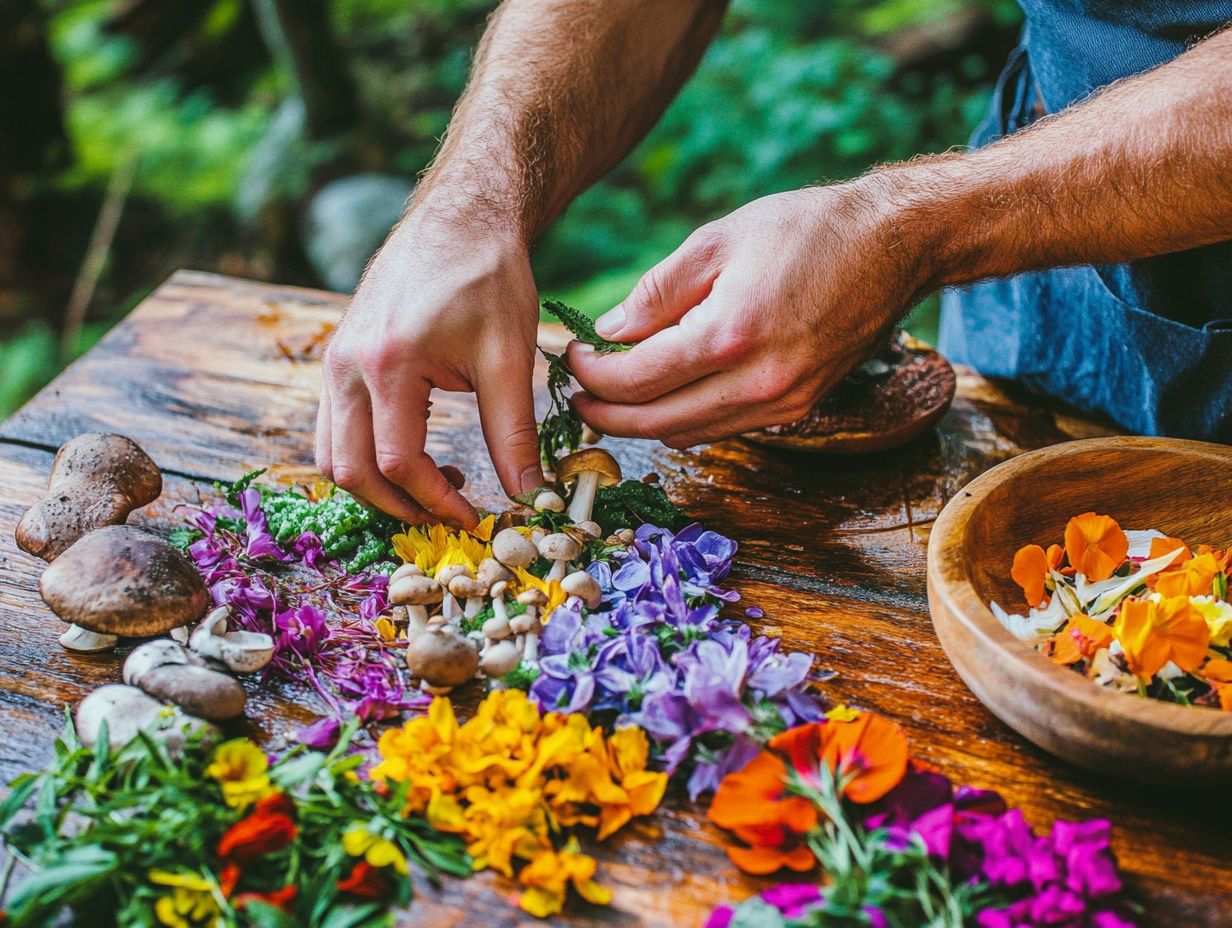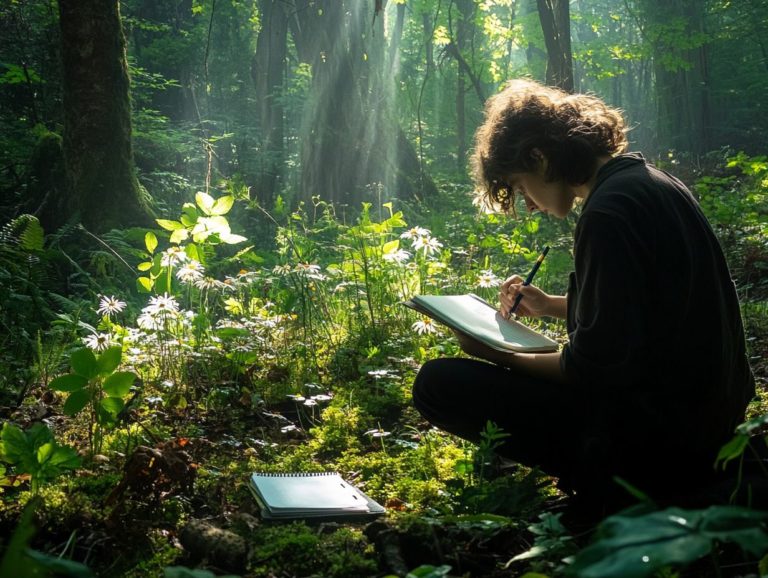How to Use Foraging in Culinary Arts
Foraging is more than a trend; it’s a timeless way to connect with nature and enhance your cooking.
By gathering wild ingredients, you enhance flavors and embrace cooking that helps the environment.
This article delves into the fundamentals of foraging, showcasing diverse ingredients you can discover and how to seamlessly incorporate them into your meals.
You ll find essential techniques, seasonal guides, and inventive recipes designed to spark your own foraging adventures.
Join us on this exciting journey as we explore the art of foraging!
Contents
Key Takeaways:

- Foraging enhances flavor and sustainability by using fresh, local ingredients.
- Ethical foraging techniques are crucial for the safety and sustainability of foraged ingredients.
- Incorporating foraged ingredients into dishes adds a unique and creative element to your cooking.
The Art of Foraging
The art of foraging has captured considerable interest in recent years, seamlessly blending culinary travel with sustainable eating. This practice of gathering wild food, especially seasonal ingredients, offers you a distinctive connection to nature and the local ecosystem.
As chefs like Jocelyn Myers-Adam and Jarad Adams embrace foraging techniques, they inspire culinary enthusiasts like you to delve into local markets and cooking classes. This exploration will deepen your understanding of edible plants and equip you with the necessary skills for a rewarding foraging experience.
Understanding the Basics
Understanding the basics of foraging is essential for anyone who wants to incorporate wild food into their culinary repertoire. Knowing which edible plants and herbs are safe to consume can elevate your dishes and promote the use of sustainable ingredients. To explore what you can make with foraged edibles, dive into the world of seasonal crops.
Your journey begins with familiarizing yourself with local flora, as distinguishing between edible and toxic varieties is crucial for safe foraging. Techniques such as observing plant growth habits and understanding ecosystems can significantly enhance your foraging skills.
Seasonal awareness is key; some plants only thrive during specific times of the year, underscoring the importance of timing when gathering fresh ingredients. Engaging in foraging connects you with nature while supporting biodiversity the variety of life in an ecosystem and eco-friendly practices, reinforcing the notion that food should be sourced mindfully and responsibly.
Benefits of Foraging in Culinary Arts
The benefits of foraging in culinary arts go far beyond just sourcing unique ingredients; it elevates your entire dining experience by infusing gourmet meals with the freshness of local products and incorporating the art of foraging.
When you embrace sustainable ingredients harvested directly from nature, you create dishes that are not only bursting with flavor but also environmentally conscious. This approach allows you to reflect the seasonal bounty of your region in every plate, transforming your culinary creations into a true celebration of nature’s offerings.
Enhancing Flavor and Sustainability
Enhancing flavor and sustainability in your cooking often begins with the thoughtful incorporation of wild foods, providing unique taste profiles that reflect their natural environment. By emphasizing seasonal ingredients, you can craft dishes that are not only delightful but also mindful of their ecological impact.
Imagine introducing vibrant flavors through ingredients like wild garlic, which imparts a robust kick to your pesto, or nettles, which can be transformed into a nutrient-rich soup. These elements do more than elevate your dish; they tell a story of the land, inviting diners to appreciate local ecosystems.
By integrating these foraged treasures into your cooking, you foster a deeper connection between the plate and the environment. Advocating for sustainable practices like sourcing food responsibly and minimizing waste creates a meaningful difference in both restaurant kitchens and home cooking.
This holistic approach ensures that flavor and sustainability go hand in hand, inspiring a new generation of chefs and home cooks to view their ingredients as a precious resource.
Are you ready to explore and gather your own wild ingredients? Start your foraging journey today!
Types of Foraged Ingredients

The diverse array of foraged ingredients at your fingertips invites you to explore a world of flavors and textures, ranging from aromatic herbs and wild mushrooms to esteemed treasures like the P rigord truffle.
Grasping the intricacies of these ingredients not only enhances your cooking skills but also sparks a wave of creativity in your kitchen endeavors.
Commonly Used Ingredients and Where to Find Them
Commonly foraged ingredients like garlic mustard and wild mushrooms are often within your reach at local markets or during edible hikes, making it easy for anyone eager to dive into the world of foraging.
Identifying these treasures in their natural surroundings enhances your foraging experience and elevates your culinary creations.
Take garlic mustard, for instance. Its vibrant, peppery flavor thrives in moist woodlands and along trails, making it a delight to spot with its heart-shaped leaves and unmistakable garlic scent.
Wild mushrooms, like chanterelles and morels, can be sought out in damp, shaded areas. Always be cautious; some mushrooms can be poisonous, so careful identification is key.
Foragers must consider their effect on the environment! Harvesting sustainably guarantees that these delightful ingredients will continue to thrive for your future adventures. Exploring wild edibles enhances your palate and deepens your connection with nature, making each foraging trip all the more rewarding.
Foraging Techniques and Tips
Mastering foraging techniques methods for gathering wild food safely and sustainably is essential for a successful experience, ensuring not only your safety but also the sustainability of the ingredients you gather.
Understand the local ecosystem. Practice responsible harvesting for a rewarding culinary adventure.
How to Safely and Ethically Forage
Understanding how to forage safely and ethically is crucial, as it impacts both your well-being and the health of the ecosystem. By adhering to guidelines for sustainable ingredients and showing respect for nature, you can actively contribute to the preservation of local flora while delighting in the rich bounty it provides.
Exploring foraging areas requires a sharp awareness of local ecosystems and the ability to accurately identify edible plants to steer clear of potential hazards. Prioritizing safety is key; immerse yourself in field guides, attend workshops, and learn from seasoned foragers before embarking on your foraging adventures.
Practicing sustainable foraging means taking only what you need, ensuring there s plenty left for wildlife and allowing plants to thrive and regenerate. Emphasizing sustainability not only preserves biodiversity but also deepens your connection to the natural world.
If you re keen to explore foraging, remember to check local regulations and ethical guidelines to ensure a responsible approach. Consider starting with easily recognizable plants like dandelions and wild garlic to build your confidence.
Incorporating Foraged Ingredients into Dishes
Incorporating foraged ingredients into your dishes gives you the power to craft imaginative recipes that truly capture the unique flavors and textures of the natural world.
Whether you re preparing an exquisite gourmet meal or a simple, yet delightful side dish, foraged ingredients have the remarkable ability to elevate your culinary creations to unparalleled heights of deliciousness.
Creative and Delicious Recipes

Creative and delicious recipes that utilize foraged ingredients can elevate your meals into gourmet experiences. They showcase the artistry of chefs like Jarad Adams. From unique appetizers to exquisite desserts, foraged ingredients bring a burst of flavor that transforms your meals.
These natural treasures, often gathered from nature, introduce a unique flavor profile that enhances traditional dishes. Picture a wild garlic pesto, rich and vibrant, paired with fresh pasta, or a delicate salad featuring peppery nasturtium leaves alongside tender wild greens each bite bursting with earthy goodness.
Employing techniques such as pickling, drying, and fermenting allows chefs to capture the essence of these seasonal finds. These innovative approaches align perfectly with current trends in sustainable cooking. They encourage you to appreciate the rich tapestry of flavors that nature provides while fostering a deeper connection to local ecosystems.
Foraging in Different Seasons
Foraging in different seasons presents a remarkable opportunity to uncover a diverse array of edible plants and seasonal crops, each with unique flavors.
By understanding what to gather at various times throughout the year, you can embrace local ingredients. This ensures that every dish you create is not only fresh but also bursting with vibrancy.
What to Forage for in Each Season
Knowing what to forage for in each season helps you maximize your wild food experience, whether you’re a culinary enthusiast or a seasoned chef. From the vibrant wild garlic of spring to the rich mushrooms of autumn, seasonal ingredients add variety and significantly enhance the flavor profiles of your dishes throughout the year.
Exploring the diverse array of foraged ingredients can elevate your culinary creations. For example, during summer, you might find succulent elderberries and fragrant wild basil perfect for infusing syrups or crafting vibrant pesto sauces. In winter, hardy greens like nettles and dandelion offer nutritious options for hearty soups and stews.
Sourcing these treasures can be as simple as taking a leisurely nature walk or visiting local farmers’ markets, where foragers often share their harvest. Learning from seasoned foragers deepens your connection to the land and the bounty of ingredients flourishing within it.
Frequently Asked Questions
What is foraging in culinary arts?
Foraging in culinary arts refers to gathering and using wild, edible ingredients in cooking. It involves identifying and collecting a variety of plants, herbs, and other natural ingredients from their environments, including mastering the art of wild foraging techniques for use in recipes.
How can foraging enhance my culinary skills?

Foraging allows you to explore and experiment with new and unique ingredients, enhancing your creativity and knowledge in cooking. It also promotes a deeper understanding of the natural environment and the food we eat, making it a great way to learn how to use foraging to educate others.
What are some common foraging techniques in culinary arts?
Common foraging techniques include identifying edible plants and herbs, understanding their seasons and locations, and safely harvesting and preparing them for use in cooking. Additionally, learning how to use local resources for sustainable foraging can enhance your experience. Properly cleaning and storing foraged ingredients is crucial to ensure their safety and quality.
Are there any safety precautions I should take when foraging for culinary purposes?
Yes, always forage in safe and legal areas, and properly identify and handle plants to avoid potential hazards. It is recommended to consult with a local expert or guide when starting out with foraging.
Can foraging be incorporated into everyday cooking?
Absolutely! Foraging can be a fun and sustainable way to add new flavors and ingredients to your everyday meals. It can also be a cost-effective alternative to purchasing expensive, specialty ingredients.
Start your foraging adventure today and elevate your cooking!
What are some tips for beginners interested in foraging for culinary purposes?
Research local edible plants and herbs. Getting to know what’s around you is key to enjoying this exciting adventure!
Join a foraging club or take a class to learn how to identify and harvest safely. Always forage responsibly; it s essential to take only what you need and leave enough for nature to flourish.






